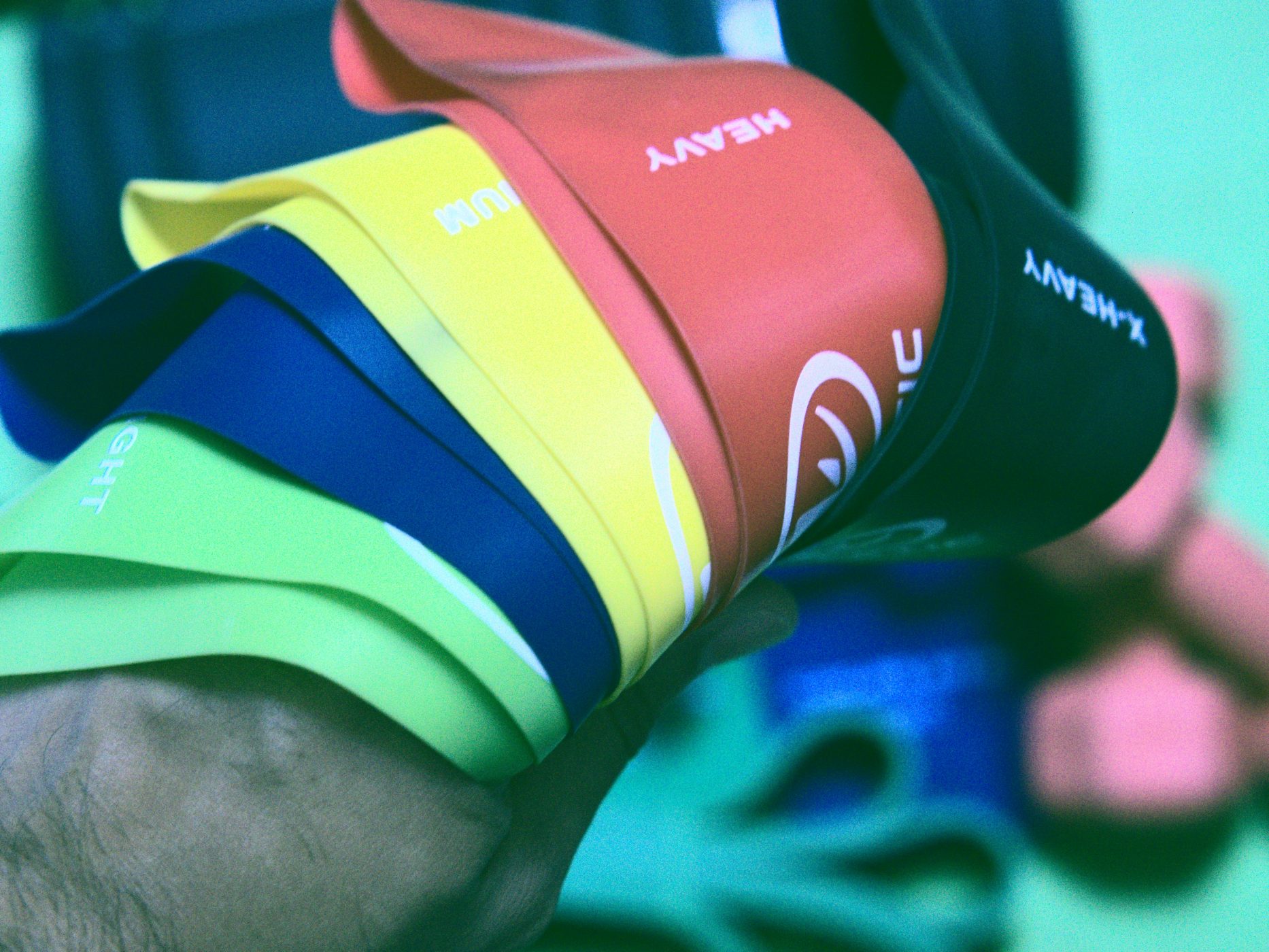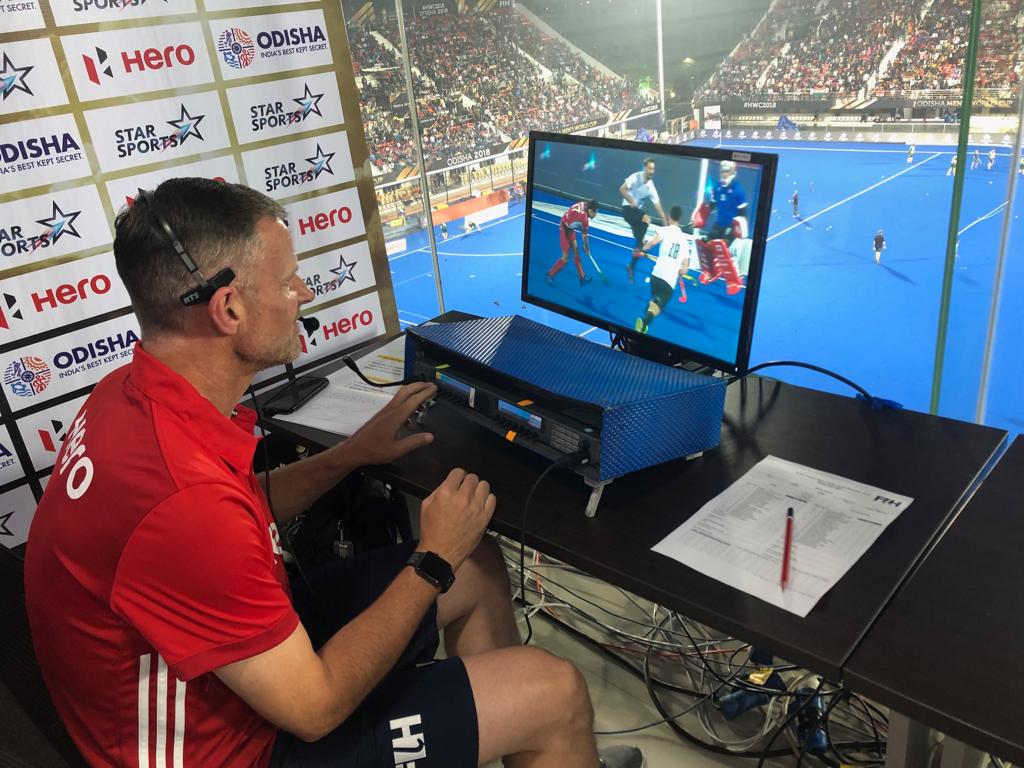How To Use Radios

Radios are becoming more and more common throughout all levels of umpiring. No longer is it only the top internationals using radios for video referrals – now it’s not uncommon to see umpires using radios at almost all levels of the game. Chances are, if you haven’t already had the opportunity to use them during a game, you will soon!
It’s important for everyone to know how to use radios in order to get the best out of them. So whether you’re experienced in using them or you’ve never worn a headset before, hopefully this post will help you make sure both you and your colleague have a great experience using them in your game.
Radios can be such a wonderful addition to our umpiring. They can be absolutely invaluable in helping to get the right decision without having to look up and take your eyes off the game! Using radios can help you keep track of players and cards, or you can talk to each other about changing your game strategy mid-game rather than waiting until half time. They help you stay on top of the match and on the same page.
But, like any tool, radios can be used well and they can be used poorly. They can enhance your umpiring ability and experience, but they can also detract from it if not used in the right way.
When used incorrectly, they can be very distracting – which doesn’t help your on-field performance. There can be too much information given, which makes things MORE confusing, not less. Saying the wrong thing also doesn’t help even when you’re trying to be helpful. I can’t tell you how many times this has happened:
Umpire 1: “Foot! Foot!”
Umpire 2: “…..”
Umpire 1: “Foot!”
Umpire 2: “WHOSE FOOT?”
Umpire 1: “Oh yeah, penalty corner”
So how do we get the most out of using radios to make sure they truly enhance the game like they should? Well, settle in my friend, and learn how to use radios to take your umpiring to the next level.

This post may contain affiliate links. This means if you purchase a product through the links on this page, I may receive a small commission from the company for sending you their way. This helps me buy enough tea to keep this site going, so I appreciate your support! Read more on the Legal Stuff page.
How to use radios to communicate effectively during your game
One of the most useful things about using radios is that you’re able to hear what your colleague is saying – not just to you, but also to the players! This means you get an even better insight into the game, knowing exactly when a subtle warning has been given, or when a particular decision or card is coming and why. Hearing the “good tackle”, “get 5m”, “play on” is also really helpful.
Then of course they also let you converse with your co-umpire with ease. You can cross-check the time, confirm the colour of a card or who it will be awarded to, check decisions, etc. As you become more comfortable using the radios you can also catch about changes in the intensity of the match, or individual player behaviour, or how you will manage changes in tempo. Being able to discuss and adjust your game plan and management strategies in real-time is INVALUABLE.
Just make sure you don’t turn that talking into a running commentary of the game. It’s distracting for your co-umpire, and not the most professional look in front of the players (and coaches and spectators). If people can hear you constantly talking, it looks like you’re not focused on the game. Additionally, if it seems you are laughing/joking about players on the field, then that’s not a good look either. So make sure you keep it professional!
Let’s get down to some basic tips and tricks on umpiring a game when mic’d up…
The Basics
-
Rule #1: Keep it simple
The most important thing to keep in mind when you’re mic’d up to your colleague is to KEEP. IT. SIMPLE. Our brains are already processing so much information when we umpire. We’re watching and making decisions and (sometimes) second guessing what’s going on, all in a second or two. Adding a running dialogue of the game into your ear isn’t really the most helpful thing. So, when communicating over the mics, keep it to only a few words. Simplicity is the key! This makes it much easier for the other umpire to understand what you’re saying.
-
Rule #2: Decision first, then reason
This is to avoid the dreaded scenario I talked about above… the “WHOSE FOOT?!” situation. Always give the decision first – i.e. PC, Free hit out, Blue ball. Then give the reason if needed to follow up – foot, danger, obstruction. This makes it clear and easy for your co-umpire to understand what you mean and avoids delays in them blowing the decision because you weren’t clear enough! This will also reduce player angst if they thought the umpires didn’t see what happened, when in reality you did, you just took too long to convey the right message.
The dos:
- Leave more time in your pre-match preparation in order to get mic’d up. It takes longer than you think it will and you don’t want to have to rush the rest of your prep!
- Have a pre-match talk! I mean, you always should, but if you’re using radios make sure you talk about them too! Make it clear to your colleague what you like through the radio. Let them know: decision first, then reason. And if you find lots of talking distracting, let them know that too! If you’re umpiring with someone who speaks a different language to you, work out how best to help each other over the mics – what words will you use?
- During the game, comments such as ‘let’s be mindful of the tackles, maybe a green for the next one’ and questions such as ‘did you see anything there?’ are very helpful ways to use the radios.
- When giving assistance, do still signal, even if you’re talking to each other about it! This let’s everyone else SEE that you’re working together as a team. Radios are an added bonus, they shouldn’t replace ‘old-school’ help.
- Following on from the point above, make sure you keep eye-contact with your colleague throughout the game. Just because you can talk to each other doesn’t mean that shouldn’t still be looking at each other too 🙂
The don’ts:
- Don’t be afraid to use radios when you umpire – they’re great!
- Don’t talk your co-umpire’s ear off… remember that having someone talk in your ear can be distracting, so let your co-umpire have some peace and only use the radios when you need to.
- Don’t let them negatively impact your umpiring – if you’re having trouble with them or you’re finding them too distracting, just take it out of your ear.
- Don’t forget that people can still see you when you’re talking to your colleague over the radios (even if they can’t hear what you’re saying) – your body language and not looking concentrated/focused can speak volumes. Make sure you keep it professional!
- Building on the point above, don’t laugh or talk about players or things that happen in a negative way. It’s definitely ok to tell your colleague how AH-MAZING their advantage goal was though 😉
- Don’t forget to keep looking at each other and signalling. Technology is an aid, not a replacement.
- Don’t forget you can still blow time and have a chat about decisions if you need.
- Don’t forget to charge your radios before your next game!
Using them for coaching
Just a quick note on coaching over the radios. If you’re actually umpiring with the person you are providing some coaching to, then it’s ok to offer some coaching over the mics every now and then. It can actually be super helpful, especially with positioning because you can tell them exactly where they should be (start running now, move a little closer in-field, you’re too deep, etc.). However, don’t overload the person you’re umpiring with. You don’t want to affect their performance because you’re constantly bombarding them with “advice”.
If you’re an umpire coach listening in (i.e. you’re not actually umpiring), then please, never talk to your umpires over the radios whilst they’re umpiring. If you have an extra radio set, it is there only so you can listen to what they are saying to the players and each other. If you want to chime in with a “great job guys” at half time, then that’s ok, but leave it at that. If your umpire is constantly worrying about your voice coming over the headset because they’ve made a mistake, then their on-field performance will suffer. Leaving the coaching until the post-game debrief.
How to wear your radio?
The actual radio normally comes with a clip on the back, which makes clipping it to the back of your pants or skirt pretty easy! But, that’s not always the case… I have come across a few that have a belt loop instead, which is easy if you’re wearing a belt, but if you have pants without a belt or you’re wearing a skirt, you might have to get a little creative. The best solution I’ve found in this case is to purchase a ‘running belt’ to pop the radio in, which you then clip around your waist/hips, either under or over your shirt as you prefer. Other people have also used arm-bands to put their radios in. Whatever you find most comfortable.
If you are putting your radio pack into something though, hot tip: make sure the cord is coming out the open end, or it’s at the end where the zip finishes when you zip it up. This stops the cord from being bent where it inserts into the radio – too much bending and it can split, which means you’ll have to buy a new radio. Booooo.
It’s generally easiest to wear your radio at the back, but some models might struggle to transmit through your body over the long distance, particularly when the weather isn’t great. In those instances maybe move it to your side, but in general you shouldn’t have too much trouble.
With the wire, feed it around under your arm if you have to attach the microphone/PTT button to the front of your shirt. This stops the wire from getting pulled over your shoulder. If you have an earpiece mic, just go straight up the back and over your ear. Just make sure you always allow a little slack in the wire to allow you to turn your head!
Finding the right earpiece for you is a bit of a journey, and it’s great to try as many as you can. I don’t really like the clear tube ear pieces that go over your ear because they don’t stay in place for me (I have little ears) and I almost always have to use some strapping tape to keep it from falling out, which I hate because it gets stuck in my hair and it doesn’t look great (call me vain, it’s probably *definitely* true…). Someone did mention to me once that the ear putty/wax that swimmers use can help to keep the actual earpiece in place though. I should try it out sometime…
I prefer the earpieces that have an attachment that sits into the grove of your ear – they don’t move and I can run around without having to worry about it falling out! You can also get attachment ear parts that sit the tube out a little, which allows you to hear from the ear your earpiece is in too (most earpieces will block the ‘outside’ hearing for the ear you have it in, so that you only hear what’s coming through the mic – this is another reason open mics are better. Because you can hear the game through the mic, it doesn’t feel like you’re completely deaf in one ear…!)
What type of radio to get and tips on using them?
Some generous associations supply their umpires with radios, whilst other umpires are buying their own. Generally, at national and international tournaments they will be supplied, but if you’d like to use them regularly in your local competition, then buying your own set is the way to go. And that’s actually much more achievable than you might think! Radio sets are getting more affordable (and useable!) all the time, which is great for us! You just have to know what you’re looking for to make sure you’re getting the right ones.
So what should you look for?
- Open-mic (also known as Full Duplex)
This is the type you want to get. You can get full duplex radios in most price brackets now and they are DEFINITELY worth paying just that little bit extra for. Being able hear everything really adds to the experience of using radios. It means you’ll be able to hear your co-umpire talking to the players. And you’ll be able to talk to them without any delay, which is the best!
- Push-to-talk (PTT)
Push-to-talk radios are less good than open mic, but still better than no radios. As you might have guessed by the name, the radios aren’t always ‘on’ – you have to push a button to talk to your colleague. This button is on an extra cord, which you normally attach to the inside of your shirt or you your skirt/belt.
A couple of things to be aware of when using PTT:
- There is usually a bit of a delay between pressing the button and them being able to hear you. So push, wait a second, then talk. Otherwise they’ll miss what you said!
- Only one person can talk at a time, so make sure you keep things clear and simple.
- Different headsets
Everyone has a different preference here, so try other people’s out to find out what you like! Sometimes, there is just an earpiece that goes into your ear, some have an attachment that sit in the grove of your ear to hold the earpiece in place, some have an ear clip that goes over the top of your ear and around the back and others might just have the clear plastic tube that I mentioned above. Then, you can have the microphone separate to the earpiece, in which case you usually clip the mic to the front of your shirt. Other times the microphone and earpiece are attached together – kind of like popstars or tv presenters wear. I actually like these the best because the mic is right near your mouth so the sound quality is usually better. They’re a little more obviously though, so if your prefer subtlety, then perhaps the separate mic/earpiece is more for you…
On a general note, when buying your own you’ll usually just get the two for the on field umpires. However, in a tournament there will usually be 4 radios to a set. 2 open mic radios for the on-field umpires, 1 radio for the reserve umpire with a PTT button, and 1 listen-only radio for the umpire manager so that they can listen to everything.
Radio Recommendations
Just a quick note, I haven’t bought these myself, they are just examples of types of radios you can buy – please do your own research into the sellers and what kind is best for you. I have used the Axiwi radios – they are great quality and a reputable company. I have also used the bluetooth motorcycle radios, which also do the job well, but you can buy them from many different companies online. As with any purchase on Amazon or eBay, please check the seller’s reviews and return policies before you buy. And depending on what country you’re viewing this from, you may need to do your own search on eBay or Amazon to get sellers that ship to you.
Lower price range
For umpires wanting to get some radios to use in their local games on a regular basis, I highly recommend going for bluetooth motorcycle communication sets. They were originally intended for people riding/cycling together in groups but make great umpiring sets too! The only thing with these though is that you can only pair two devices, so there is no opportunity for an umpire coach or reserve to listen in, but if you don’t need this then these are perfect. They are also very affordable (about $100-140 Australian dollars) and well worth the investment! Just make sure you get the sports/referee headsets, not the motorcycle helmet headsets!
Some examples are these on eBay or these on Amazon.
Mid range price
Stepping up to the next level brings you to umpire/referee specific sets, which normally come with an extra radio for coaching/reserve umpires (or at least the capability to pair with more radios). The sound quality also generally goes up too. They’re a little pricier ($300-500 Australian dollars), so are probably better for regional associations or people who regularly umpire coach too.
These on eBay are a good example. Amazon also have similar ones, but the range isn’t as good in Australia. If you’re somewhere else you might have more luck!
Top range
At the top end of the price spectrum you obviously get a great communication system. The best I’ve had the pleasure of using so far are AXIWI – they’re super light and small, very easy to use and have great sound quality. But they are probably out of most people’s individual price range, so might be best for associations to buy for their umpires to use, or for tournament type situations. Or get together with a group of friends and share the love! Another option is radios by RefsWorld, but I haven’t tried those…
Wrapping up…
Hopefully this has provided you with a few tips to get the most out of using radios in your umpiring. They are such a great tool when used properly and can really take your umpiring to the next level!
If you don’t have access to a set on a regular basis, it’s well worth investing in a set of your own. They are relatively inexpensive, and if you follow these guidelines you’ll make the transition with ease.
If you think other people might find this useful, please share it around through social media or by using the buttons below 🙂 Sign up for the newsletter to get new posts delivered straight to your inbox, and follow me on Facebook, Instagram and Pinterest for extra tips, tricks and behind the scenes banter!




You must be logged in to post a comment.